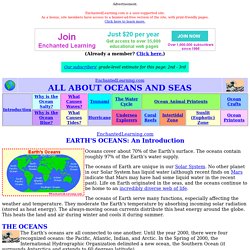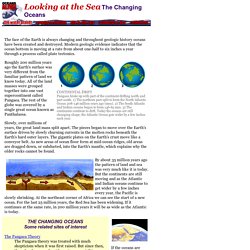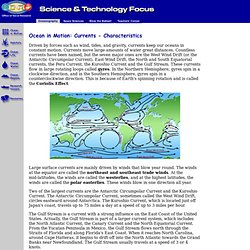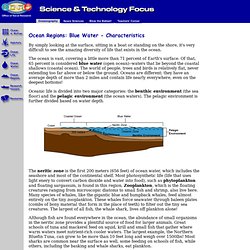

Oceans. Food, work, fun, adventure, sport and life – not many things can give us all those things in one.

Every day the oceans give us the air we need to breathe; the weather to grow crops; water to support the smallest to the largest animals on earth and 80% of all species; vast ice flows to help regulate our climate; millions of jobs and a life-time of pleasure. Send us your favourite ocean image and it could be featured here! You and I are alive right now because of the oceans. There is no other place in the universe so full of life as this planet; so green, so rich in diverse, beautiful, weird and wonderful, large and small species, on land and at sea and it is all because Planet Earth is Planet Ocean.
They are home to the largest animal our planet has ever known – the now-endangered blue whale - but there are still huge areas of ocean that humans have never seen. Earth's Oceans. Advertisement.

EnchantedLearning.com is a user-supported site. As a bonus, site members have access to a banner-ad-free version of the site, with print-friendly pages.Click here to learn more. (Already a member? Click here.) EnchantedLearning.comEARTH'S OCEANS: An Introduction. The Water Planet. If you look down at our planet from outer space, most of what you see is water; 71% of the planet's surface is covered by ocean and it is because of this that the Earth is sometimes called "the water planet".

Only about three-tenths of our globe is covered with land. The Water Planet. Physical Features of the Ocean. The Changing Oceans. The face of the Earth is always changing and throughout geologic history oceans have been created and destroyed.

Modern geologic evidence indicates that the ocean bottom is moving at a rate from about one-half to six inches a year through a process called plate tectonics. Roughly 200 million years ago the Earth's surface was very different from the familiar pattern of land we know today. All of the land masses were grouped together into one vast supercontinent called Pangaea. The Water Planet. Millions of years ago there were no oceans on the planet.

The surface of the Earth was so hot that water simply boiled away. But volcanoes poured huge amounts of steam into the atmosphere and as the Earth cooled down the steam turned to water vapor that condensed as droplets and began to fall as rain. National Oceanic and Atmospheric Administration - Ocean. The ocean covers 71 percent of the Earth's surface and contains 97 percent of the planet's water, yet more than 95 percent of the underwater world remains unexplored.

The ocean and lakes play an integral role in many of the Earth's systems including climate and weather. One of every six jobs in the United States is marine-related and over one-third of the U.S. Gross National Product originates in coastal areas. Oceanography. Oceanography. Oceanography. Driven by forces such as wind, tides, and gravity, currents keep our oceans in constant motion.

Currents move large amounts of water great distances. Countless currents have been named, but the seven major ones are the West Wind Drift (or the Antarctic Circumpolar Current), East Wind Drift, the North and South Equatorial currents, the Peru Current, the Kuroshio Current and the Gulf Stream. These currents flow in large rotating loops called gyres. In the Northern Hemisphere, gyres spin in a clockwise direction, and in the Southern Hemisphere, gyres spin in a counterclockwise direction. This is because of Earth's spinning rotation and is called the Coriolis Effect. Large surface currents are mainly driven by winds that blow year round. Oceanography.
Mammals are a group of vertebrates (animals that have a backbone).

Certain characteristics separate them from all other animals: mammals breathe air through lungs, give birth to live young, produce milk for their young, are warm-blooded, and have hair or fur. They also have relatively large brains and a variety of tooth sizes and shapes. Marine mammals have adapted to life in the ocean. More than 100 mammals depend on the ocean for most or all of their life needs. Marine mammals have all the characteristics of mammals, but they have different appearances and survival strategies. Marine mammals are divided into three orders: Carnivora, Sirenia and Cetacea. Oceanography. By simply looking at the surface, sitting in a boat or standing on the shore, it's very difficult to see the amazing diversity of life that exists in the ocean.

The ocean is vast, covering a little more than 71 percent of Earth's surface. Of that, 65 percent is considered blue water (open ocean)--waters that lie beyond the coastal shallows (coastal ocean). The world of people, trees and birds is relatively flat, never extending too far above or below the ground. Oceans are different; they have an average depth of more than 2 miles and contain life nearly everywhere, even on the deepest bottoms! Oceanography. Sometimes currents occur along the coast and only affect small areas.

Oceanography. Everything from earthquakes to ship wakes creates waves; however, the most common cause is wind. As wind passes over the water's surface, friction forces it to ripple. Oceanography. Tides are the periodic rise and fall of the ocean waters. They are caused by the gravitational pulls of the Moon and (to a lesser extent) Sun, as well as the rotation of the Earth. The Sun and Moon pull on the Earth, the water, even you! But gravitational attraction depends on distance and mass. For example, you have very little mass and you're very close to the Earth, so the Sun and Moon can't just yank you off the planet. The Sun is extremely massive, but it is an average of 93 million miles (150 million km) from Earth, compared with about 238,866 miles (384,400 km) from here to the Moon.